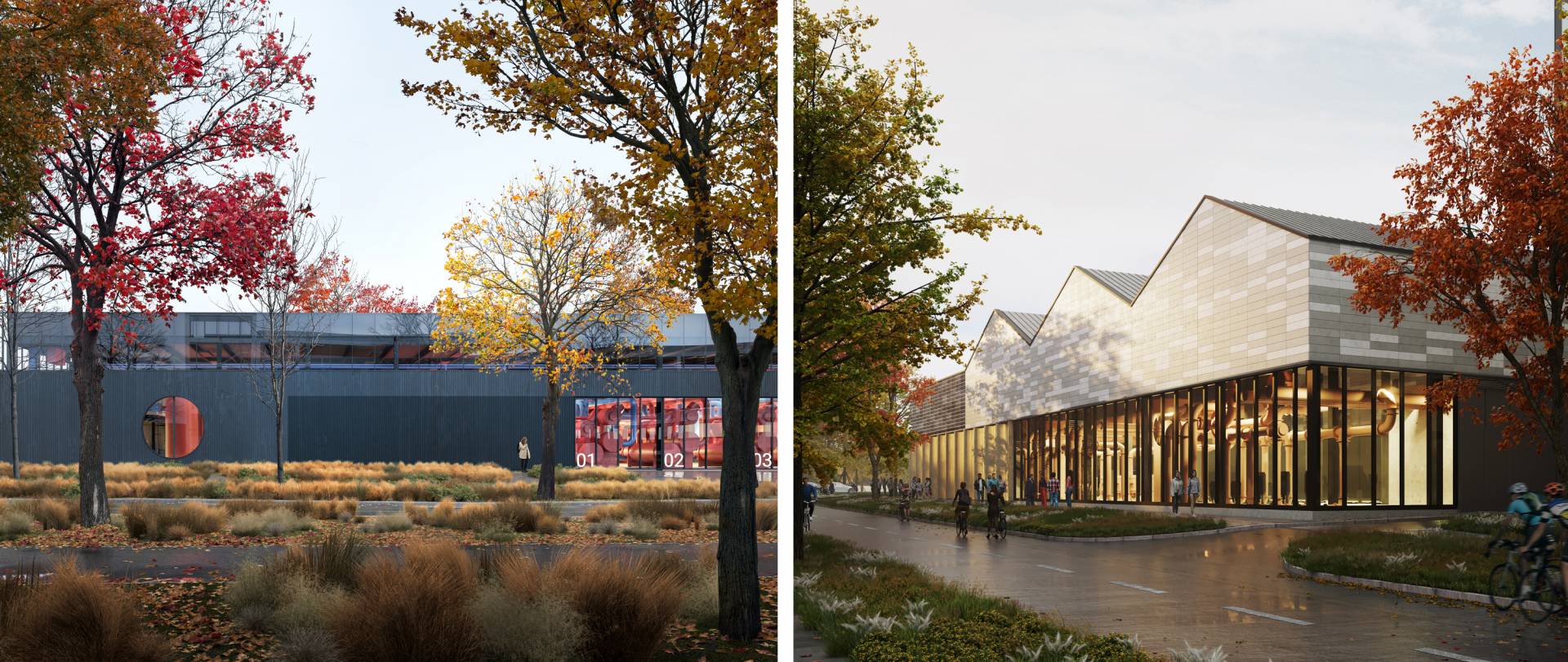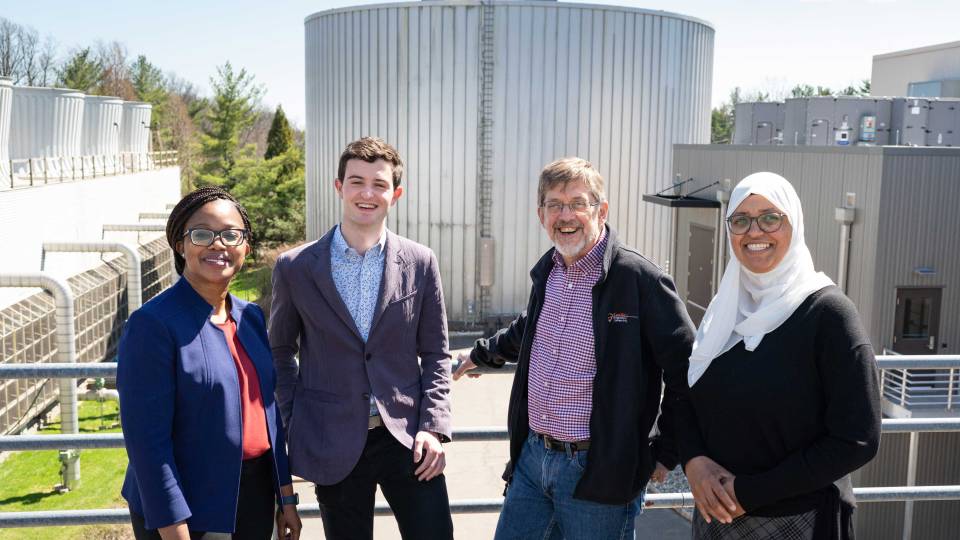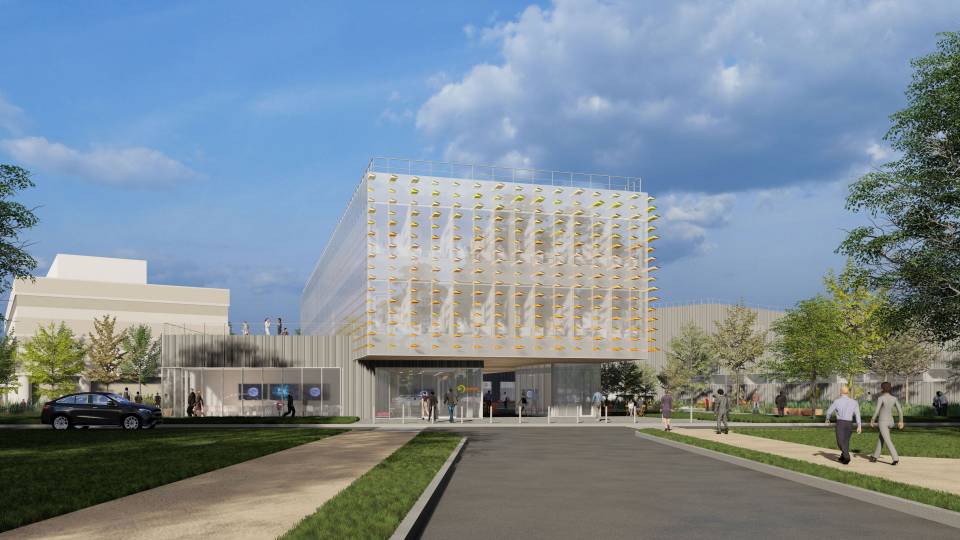Princeton is phasing out steam generation for heating and instead implementing a new low-temperature heating water energy system driven by electric heat pumps, thermal storage and geo-exchange, which captures heat from inside campus buildings in the summer and stores that energy in the ground until it is needed again in the winter. The University is one of the first sites in the nation to combine these technologies at this scale.
For Princeton University to meet its energy needs, along with its goal of achieving net-zero carbon emissions by its 300th anniversary in 2046, a complete rethinking is required on how energy is used and supplied in every lab, every office, every dorm room, in each parking lot and garage — even on pathways and playing fields.
The groundwork for this massive undertaking is being installed now as the University undergoes one of the most extensive building programs in its history over the next decade.

Workers lower a drill into the earth that will dig out one of the hundreds of bores that comprise Princeton’s geo-exchange system.
Like most institutions, Princeton historically has relied upon energy sources — primarily steam heat and electricity — that are powered by burning fossil fuels. Today, the University is moving toward a system that will employ a combination of combustion-free technologies to optimize and reduce overall energy usage and eliminate carbon emissions.
Princeton is phasing out steam generation for heating and instead implementing a new low-temperature heating water energy system driven by electric heat pumps, thermal storage and geo-exchange, which captures heat from inside campus buildings in the summer and stores that energy in the ground until it is needed again in the winter. The University is one of the first sites in the nation to combine these technologies at this scale.
The district energy system (as it is known in industry terms) simultaneously will provide for the University’s other major energy needs — heating water (for domestic hot water and heating spaces), chilled water (for cooling spaces and equipment such as lasers, electron microscopes, CT scanners and computer facilities), and delivering electricity via a microgrid. Ultimately, it will be powered almost entirely by electricity generated from renewable sources, including Princeton’s own supply of solar energy(Link is external).
“By 2046, we should have a super energy-efficient campus with a system that’s super reliable, and one that’s fully powered through renewable energy,” said Ted Borer, director of Princeton’s Energy Plant. “Princeton has the opportunity to lead by example, so even in our facilities, people are going to look at us and say, ‘Wow, now that I see what Princeton has done, I get it. I can follow their thought process at my facility.’ We can influence thousands, tens of thousands, even millions of others by our actions on campus.”
These measures — and the elimination of carbon emissions globally — are critical in light of the 2021 report by the Intergovernmental Panel on Climate Change(Link is external), which warned of the “unequivocal” impact of human behavior upon the Earth’s climate.
The University is well on its way to making significant shifts in its energy use, as mapped out in the “Net-Zero America(Link is external)” report from Princeton’s Andlinger Center for Energy and the Environment and High Meadows Environmental Institute. Every scenario proposed by the researchers involved massive investments in energy efficiency, extensive electrification in transportation and buildings, energy storage and unprecedented expansion of clean energy production.
Leading the way to sustainable campuses of the future
Niels Vilstrup, head of district energy advisory in North America for the Danish Trade Council, said Princeton’s approach to district energy on its campus is setting the stage for the types of changes that need to occur at other universities and institutions worldwide.
The Danes have a special interest in learning from and guiding others through these energy transitions. Copenhagen, which has a long history of district energy and sustainable energy technologies, is on track to become the first carbon-neutral city in the world in four years, Vilstrup said. It has been a beacon to other municipalities the way Princeton hopes to be for other schools as the University leaps generations ahead from steam energy to one of the largest geo-exchange systems.
“Somebody has to take these first steps,” Vilstrup said. “It’s definitely not an easy task, but it’s amazing that Princeton took the whole package here and is going this way, because it will be leading the way for a lot of other campuses to come.”
Princeton’s steam distribution system runs through a network beneath the campus and serves 180 buildings, some dating back to the 1700s. “It’s a fairly inefficient delivery system, and we can do much, much better than that,” Borer said. “We estimate that 20% of the energy we create never makes it to the buildings — it’s lost out into the ground, which is colder than the steam in the pipe.”
Princeton’s new hot water heating system has many advantages compared to steam. Primarily, it operates at a far lower temperature, which requires less energy. Whereas buildings on campus have traditionally received steam heat at 450 degrees, they will now be supplied with hot water heat at 140 degrees.
To reduce the overall load on the new system, Princeton is actively improving the efficiency of its existing buildings. This can involve replacing single-pane windows with double- or even triple-pane windows. It also involves adding insulation where needed and air sealing buildings to eliminate the loss of heat in the winter and cooled air in the summer.
Life-cycle cost analysis shows it’s less expensive to build, maintain and operate the new systems than it is to continue operating the existing systems. “Overall, upgrading the buildings and converting from steam to district hot water, using heat pumps, thermal storage and geo-exchange should result in the university heating and cooling systems requiring about one-sixth as much input energy as they do today,” Borer said.
Geo-exchange: the ‘thermal piggy bank’
Conversion to hot water heating is only one part of Princeton’s shift toward a more sustainable future resulting in net-zero emissions.
New Jersey’s hot summers and cold winters make it ideal for Princeton to supply heat through geo-exchange(Link downloads document), which relies on heat pumps to capture, save and recirculate summer’s heat for winter.
“This is a situation where we’re able to capture energy that might otherwise be wasted and use it later,” said Justin Grissom, a project manager for Kansas City-based Burns and McDonnell, which is providing overall program management of the central campus’ multiple geo-exchange project components and is the engineer of record for the existing thermal facility conversion projects. “Basically, the ground becomes a big battery, storing heat energy. It’s not an electrical battery, but a thermal battery.”
In most institutional settings, the heat pumped out of buildings during the warmest months is rejected into the atmosphere using cooling towers, Grissom said.
Princeton will gather that heat through nearly a thousand geo-exchange bores on its existing campus and more than 200 bores at its new Lake Campus, off Washington Road in West Windsor, New Jersey, where it will be stored within the rock beneath the Earth’s surface. The bores, deep holes that are being dug to 850 feet on the existing campus and 600 feet at the site of the new construction, contain a closed-loop system of piping that recirculates water through the ground.
The piping is surrounded by grout so that the water within the pipes never comes in direct contact with subterranean water sources or the rock itself, which will be heated to 90 degrees via conduction.
Princeton already uses geo-exchange on a smaller scale at Princeton’s Lakeside and Lawrence apartments, and also at the Lewis Center for the Arts. As part of its overall campus plan, Princeton eventually will add geo-exchange capacity beneath the new Roberts Stadium and East Garage, as well.
Performing at the cutting edge of efficiency
While geo-exchange technology is not new, Princeton’s simultaneous use of geo-exchange and heat recovery chillers is novel, said Brandon Dachel, associate vice president and senior mechanical engineer for Salas O’Brien, engineer of record for the geo-exchange fields and design and the TIGER facility(Link is external).
The University’s new heat recovery chillers will capture heat created as a byproduct of cooling air in campus buildings. In Princeton’s current system, that heat is rejected through the cooling tower at the University’s Cogeneration Plant(Link is external), which is the central facility where steam and chilled water are produced.
“With a heat pump, you’re able to make chilled and hot water with the same machine, so where you traditionally reject heat through a cooling tower, we’re recovering that heat and sending it to the heating hot water system,” Dachel said.
On a campus like Princeton’s, there’s typically always some need for heating and cooling no matter the season, Dachel said. Borer explained: “On the coldest day in the winter, we still need to remove heat from laboratory equipment and computers. On the hottest day in the summer, we still need to deliver heat for sinks, showers, dishwashing, air-conditioning ‘reheat,’ and equipment such as sterilizers, cage washers and autoclaves.”
Because the technology for heating and cooling will be contained in one system instead of two, and because it does not require combustion as an energy input, it will allow for more precise, efficient and cost-effective temperature control, said Vladimir Mikler, principal of Integral Group in Vancouver, British Columbia, the engineer of record for the Lake Campus geo-exchange system.
Integral Group worked with Princeton to perform a sophisticated hourly analysis to project the energy needs for Princeton’s new construction through an entire year.
“As part of the design we have developed the system, not only in terms of its peak capacities, but we’ve also designed the system in a way to perform optimally throughout the course of the year,” Mikler said.
Princeton will be able to produce heated and chilled water at optimal times, drawing electricity when it’s at its cheapest rate, instead of during peak periods. The heated and chilled water will be kept in thermal energy storage or TES tanks near the two main geo-exchange sites until it is needed, offering ready supply on days in the summer and winter with the heaviest loads.

Two state-of-the-art, LEED-certified facilities will house controls for Princeton’s new energy system, TIGER (left) and TIGER CUB (right). TIGER stands for thermally integrated geo-exchange resource; CUB is an acronym for central utility building.
TIGER and TIGER CUB
Controls for these systems will be housed within two new facilities: TIGER and TIGER CUB. (TIGER stands for thermally integrated geo-exchange resource; CUB is an acronym for central utility building.)
The University needed two facilities to operate the systems most efficiently, reliably and cost effectively. As new construction on a relatively flat site, the Lake Campus systems will be able to operate at even lower hot water temperatures and use HDPE pipe instead of carbon steel that is required on the central campus hillside.
Princeton’s new facilities(Link is external) include graduate student housing and amenities that will be LEED and Passive House(Link is external) certified, a racquet center with a fitness space, a softball stadium, flexible rugby and recreation fields, a cross-country course, and a parking garage with rooftop solar capacity.
Given that new construction at Lake Campus is being built above the highest current energy standards and will have a lower overall energy load, its hot water system will operate even more efficiently at 120 degrees — 20 degrees lower than the existing campus.
Future construction at Princeton will meet or exceed the highest sustainability standards, allowing for reduced infrastructure and utilities that need less energy.
“Princeton is very good at big-picture thinking and holistic thinking,” said Justin Chin, associate principal for Integral Group. “Their first approach, which is the correct approach, is to design systems passively to not need the energy to begin with. Then whatever energy needs remain, to try to solve them in the most efficient way possible — in this case with electric heat pump technology and low-temperature heating water.”
Both TIGER and TIGER CUB are designed to achieve LEED, or Leadership in Energy and Environmental Design, certification from the U.S. Green Building Council, with a system of passive ventilation and cooling for the equipment they will contain.
“That was one of those goals that Princeton had that was quite admirable — to push us all to get the best out of the buildings that we’re designing, and the systems that we’re specifying,” said Maryam Katouzian, principal of ZGF Architects.
Both buildings were designed as showcase facilities, reflecting Princeton’s desire to highlight its sustainability mission, Katouzian said.
“Princeton wants everyone to know what they have taken on, and they want people to learn from it — they’re setting the stage for that,” she said. “It gave us the opportunity to use the architectural aesthetics to our advantage and not look at this building as a ‘back-of-house’ design. You want people to look at this building from afar and want to come closer to it and understand what is going on inside.”
Princeton as a model for sustainable energy
The installation and implementation of Princeton’s new district energy system is providing opportunities for learning and teaching.
Princeton professors, including Forrest Meggers, associate professor of architecture and the Andlinger Center for Energy and the Environment and co-director of the Program in Architecture and Engineering, have worked with the University’s energy and facilities professionals, as well as its consultants, to test and measure the performance of the new systems.
In addition, students, community members and representatives of institutions interested in sustainable energy have been given the opportunity to engage with Princeton’s new energy systems through tours of its facilities.
“They’re interested in hearing about the mechanics of it, the cost of it,” said Ijeoma Nwagwu, assistant director for academic engagement and campus-as-lab initiatives in the Office of Sustainability. “One important thing is also the thought process that has gone on, as well. There’s been a lot of that kind of engagement. We’re talking about our energy journey and why we’re moving to geo-exchange as part of a larger educational effort.”

Getting to net-zero
As part of its plan to reach net-zero emissions by 2046, Princeton is installing a new hot-water energy system driven by electric heat pumps, thermal storage and geo-exchange — becoming one of the first sites in the nation to combine these technologies at this scale. The system will be powered by renewable energy sources, including solar. The schematic pictured above offers a glimpse of how the system will work with Princeton’s new construction off Washington Road in West Windsor. A similar system is being installed on the existing campus.
- Campus buildings: During summer months, heat is removed from campus buildings. The heat is transferred into the water stream that returns to TIGER CUB (Princeton’s thermally integrated geo-exchange resource central utility building), where it is then directed into the geo-exchange bores and stored in the rock beneath the surface. In winter, the heat is pulled out of the ground and returned to TIGER CUB and campus buildings via the same system.
- Low-temperature heating and chilled water distribution lines: Distribution pipes carry chilled water (at 40 degrees Fahrenheit) for cooling spaces and heated water (at 120 degrees Fahrenheit) for heat and hot water from TIGER CUB to campus buildings. They also send heat from campus buildings to TIGER CUB, where it is directed into the geo-exchange piping and stored in the geo-exchange field in the summer.
- TIGER CUB/heat recovery chiller facility: The main facility controlling the energy needs for the Lake Campus, TIGER CUB is being built to achieve LEED certification from the U.S. Green Building Council, with a system of passive ventilation and cooling for the equipment it will contain. It will house heat recovery chillers, machines that capture heat generated during the process of chilling water.
- Geo-exchange piping: Geo-exchange piping will send heated water from TIGER CUB (either harvested from campus buildings that are being cooled or captured by the heat recovery chillers) to be stored in the geo-exchange field. At times when heat is needed for campus, it will transport the energy back from the geo-exchange field to TIGER CUB.
- Geo-exchange field: Geo-exchange bores, holes dug 600 feet deep on the new campus (and 850 feet on Princeton’s existing campus), will contain piping that recirculates water in the ground, transferring heat energy to the rock beneath the surface via conduction. The rock is heated to 90 degrees, energy that is stored there until it is needed in the winter.
- Heating and chilled water thermal energy storage tanks: Thermal energy storage tanks will store heated and chilled water that are produced at optimal times for the lowest cost and greatest energy efficiency. That water can then be drawn down and supplied to the campus during periods of high demand.
- Backup hybrid coolers: In the summer, when the geo-exchange field is warm and unable to absorb additional waste heat from the cooling process efficiently, the backup hybrid coolers will reject waste heat into the atmosphere. The coolers can operate in dry or wet/hybrid mode. In dry mode, cool air is blown across the warm water coils, like a typical car radiator. When more heat needs to be rejected, the coolers can operate in wet/hybrid mode, where water is sprayed and evaporated to pre-cool the air, prior to blowing over the coils. The pre-cooled air will absorb more waste heat from the coil before being rejecting into the atmosphere.
- Electrical yard: The main electrical feed for the new area of campus enters at the electrical yard, where it is distributed to buildings and facilities, running primarily on renewable energy including Princeton’s own solar panels. A generator will be installed there, keeping TIGER CUB up and running in the event of a power outage.




